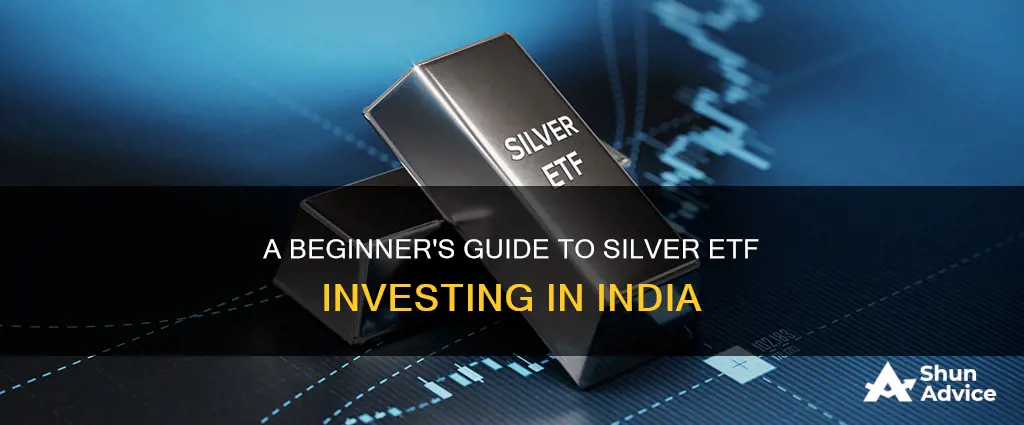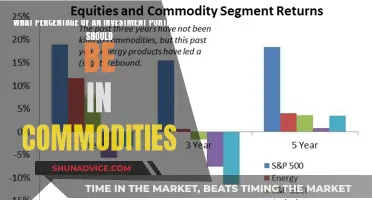
Silver is a precious metal that has been used for a variety of industrial, investment, and jewellery purposes. Silver ETFs (Exchange-Traded Funds) are a type of investment product that allows investors to gain exposure to the price of silver without having to hold the physical metal. In India, the first Silver ETF was launched by ICICI Prudential Mutual Fund on January 5, 2022, and since then, several other mutual fund houses have followed suit. Investing in Silver ETFs can be a good way for Indians to diversify their portfolios and hedge against inflation, as silver is considered to have a low correlation with other asset classes. However, it's important to note that investing in any ETF requires a demat account, and there may be associated costs such as storage and insurance that need to be considered.
What You'll Learn

Silver ETF investment requirements
Silver ETFs (Exchange-Traded Funds) are a great way to invest in silver without the hassle of buying and storing physical silver. Here are the requirements you need to fulfil to invest in Silver ETFs in India:
- Have a Demat and Trading Account: To invest in Silver ETFs, you need to have a demat account and a trading account. These accounts are necessary as Silver ETFs are traded on stock exchanges.
- Minimum Investment Amount: When investing in Silver ETFs during the New Fund Offer (NFO) period, there is usually a minimum investment amount required. For example, the Nippon India Silver ETF had a minimum investment amount of Rs. 1,000 during its NFO, while the ICICI Prudential Silver ETF had a minimum investment of Rs. 100.
- Brokerage Account: If you are a new investor, you must know that investing in Silver ETFs is different from investing in typical mutual fund schemes. You need to have a brokerage account and a demat account to buy and sell these ETFs on an exchange.
- Fund House Due Diligence: Before investing in a Silver ETF, conduct due diligence on the fund house offering the ETF. Check their reputation, fees, and the performance of their other financial products.
- Understanding Risk and Returns: Silver ETFs can be volatile, and their returns may not be as high as other investments. Understand the risks and potential returns associated with Silver ETFs before investing. Diversifying your portfolio with a small percentage of Silver ETFs (5-10%) is generally recommended.
- Long-Term Investment Horizon: Silver ETFs are typically recommended as a long-term investment. The prices of silver can be influenced by various factors, and holding the investment for the long term can help smooth out short-term volatility.
Investing at 25: Building a Balanced Portfolio for the Future
You may want to see also

Silver ETF vs physical silver
Silver ETFs are commodity-based ETFs that invest a minimum of 95% of their corpus in physical silver or silver-related derivative products. Silver ETFs are traded on the stock exchange, so you need a Demat and trading account to invest in them. They offer high liquidity and are a good way to diversify your portfolio. Silver ETFs are also a good hedge against inflation and volatility in the equity market.
Physical silver, on the other hand, requires you to incur the cost of locker rent for storage as well as insurance premium for the risk of theft. There is also a GST cost at the time of purchase for which credit is not available to a small investor at the time of sale, thus reducing the extent of the return.
Silver ETFs are a more advantageous way to invest in silver than owning the precious metal physically. Silver has a significantly lower specific weight and features a lower cost per unit than gold. However, silver is usually only the second choice for investors because it is less scarce and used much more for industrial purposes. Therefore, the silver price is a lot more sensitive to economic fluctuations and the associated risk is considerably higher than for gold.
Silver ETFs are also more cost-efficient than physical silver. The expense ratio of a silver ETF is capped at 1% as per SEBI regulations. This includes the cost of holding, storage, and insurance. In contrast, the cost of holding silver in MCX is around 6% annually, and the cost of storage is at least 40-50 bps higher than gold.
Group Investment Management: Strategies for Success
You may want to see also

Silver ETF vs gold ETF
Silver and gold ETFs have been grabbing investor attention in India, especially after bouts of softer U.S. data, which boosted prospects of an interest rate cut. Both metals are considered a store of wealth for investors and are often used to preserve wealth during financial and political uncertainty.
Gold ETFs
Gold ETFs are a unique financial instrument whose underlying asset is physical gold. They are passive tools of investment that track domestic gold prices and can be traded on the stock exchange. Gold ETFs are documents, contracts, or certificates in paper or electronic form, with their value derived from the gold that acts as the underlying asset. One unit of gold ETF equals 0.1 to 1 gram of standard gold bullion of 99.5% purity. Gold ETFs offer a convenient way to invest in gold as investors do not need to spend a lot on storing or transporting their investments. They can be bought and sold freely on the stock exchange, and investors only need an active Demat account to hold their gold ETFs in digital form. Gold ETFs are highly liquid and carry no wealth or transaction tax. They are also an excellent tool for diversifying portfolios and offer high returns during uncertain economic climates or when other markets are down. However, they carry significant market risk due to the scarcity of the physical commodity.
Silver ETFs
Silver ETFs are financial assets that invest at least 95% of their total assets in physical silver, which is typically 99.9% pure. The price of silver directly influences the net asset value (NAV) of silver ETFs. Like gold ETFs, silver ETFs eliminate the extra cost and worry of safekeeping the precious metal. Silver ETFs can be purchased and sold with a Demat account, just like stocks. Silver is a safe-haven asset, protecting investors from major losses during crises or inflation. Silver has an edge over gold due to its use in key industrial applications, especially in the global push for green energy and the increasing demand in areas like 5G, photovoltaics, and automotive industries. Silver ETFs can be more volatile than gold ETFs, but this volatility can be beneficial for traders looking to benefit from short-term price fluctuations. Silver ETFs have lower demand than gold ETFs, so they cannot be expected to provide very high returns.
Both gold and silver ETFs have their advantages and disadvantages. Gold ETFs are more stable and liquid, making them suitable for risk-averse investors. On the other hand, Silver ETFs have the potential for higher returns due to their volatility and industrial demand, but they are less liquid. When deciding between gold and silver ETFs, investors should consider their investment goals and risk tolerance.
Understanding SAP's Portfolio Investment Strategy
You may want to see also

Silver ETF taxation
For taxation purposes, profits from Silver ETFs are treated as capital gains. The taxation rate depends on the holding period of the investment. If the Silver ETF units are sold after 36 months, the profits are considered long-term capital gains and are taxed at a flat rate of 20%. On the other hand, if the units are sold within 36 months, the profits are treated as short-term capital gains and are taxed according to the slab rate applicable to the investor's regular income.
When investing in physical silver in India, there are additional costs to consider, such as locker rent for storage and insurance premiums in case of theft. Moreover, there is also a Goods and Service Tax (GST) cost incurred at the time of purchase, which cannot be claimed as a credit by small investors when selling, reducing the overall return on investment.
Silver ETFs, on the other hand, offer a more tax-efficient structure. The expense ratio of a Silver ETF is typically higher than that of a Gold ETF due to the higher storage costs associated with silver. However, the overall expenses, including the cost of holding, are capped at 1% for Silver ETFs, making them a more cost-effective option for investors.
It is important to note that the taxation rules for Silver ETFs in India may change over time, and investors should consult with a tax professional or financial advisor to understand the most up-to-date information and how it applies to their specific circumstances.
Smart Investing: 7 Lakh Rupees in India
You may want to see also

Silver ETF investment suitability
Silver ETFs are a good option for investors looking to diversify their portfolios and hedge against inflation. Silver is a precious metal with a variety of industrial uses, including in new age technology such as renewable energy products and electronics. Its demand spans across industries, investments and jewellery.
Silver ETFs are a more cost-efficient way to invest in silver compared to buying physical silver or trading in the MCX's derivative markets. This is because the cost of holding silver in the MCX is higher than gold, and the cost of storage is also significantly higher. Silver ETFs are also more liquid than physical silver, as they can be sold on the stock exchange at any time. Additionally, investors do not need to incur the cost of locker rent for storage or insurance premiums for the risk of theft.
However, it is important to note that silver prices tend to be more volatile than gold prices due to their correlation with gold and additional volatility from industrial demand. Silver ETFs may be more suitable for investors with a high-risk profile.
When selecting a Silver ETF, it is recommended to choose a reputable fund house as there is not much difference in performance between different ETFs. Investors should also be mindful that silver ETFs should only make up 5-10% of their portfolio, and they should not invest in silver if they already have gold as a hedge.
Overall, Silver ETFs are a good option for investors looking to diversify their portfolios, hedge against inflation, and benefit from the growing demand for silver in industrial applications.
Indian Chickpea Exports: A Smart Investment Strategy
You may want to see also
Frequently asked questions
A Silver Exchange-Traded Fund (ETF) is a commodity-based fund offered by mutual fund houses where 95% of the corpus is invested in silver or silver-related derivative products.
Silver ETFs are a good way to diversify your portfolio and hedge against inflation. Silver is also a precious metal with industrial uses, so it has a high demand that is expected to increase with new technologies.
You need a demat account and a trading account to invest in Silver ETFs as they are traded on stock exchanges. You can also invest through a fund house during the New Fund Offer (NFO) period.







